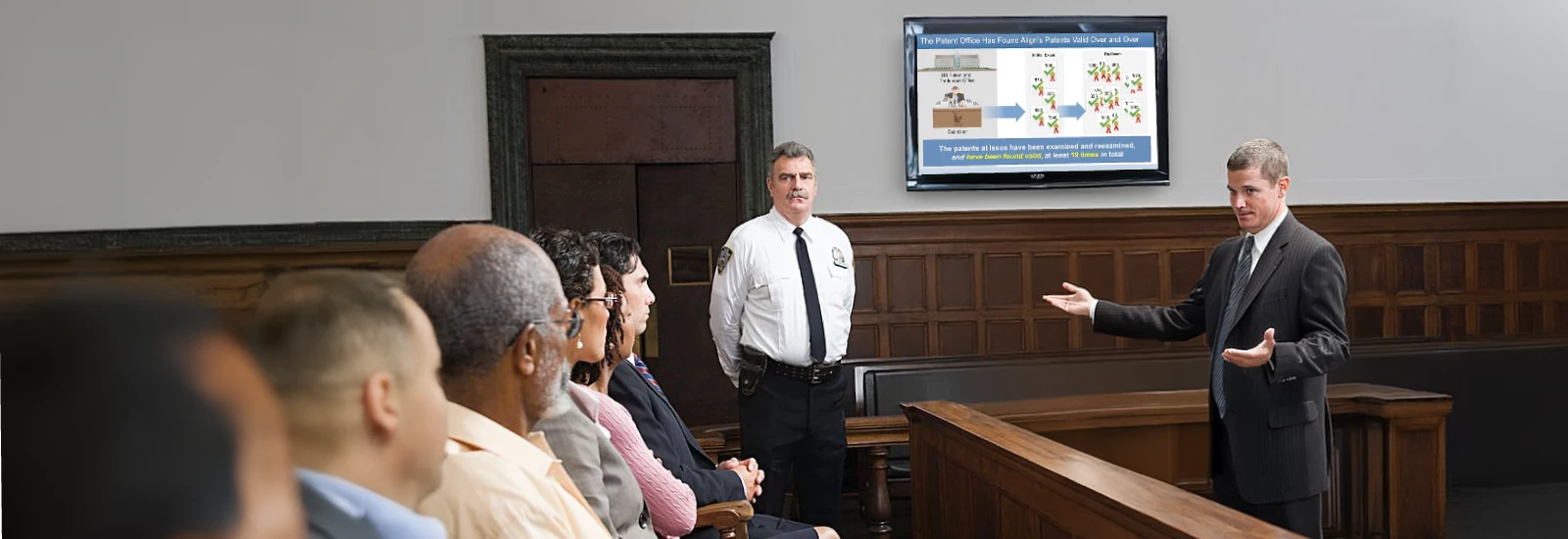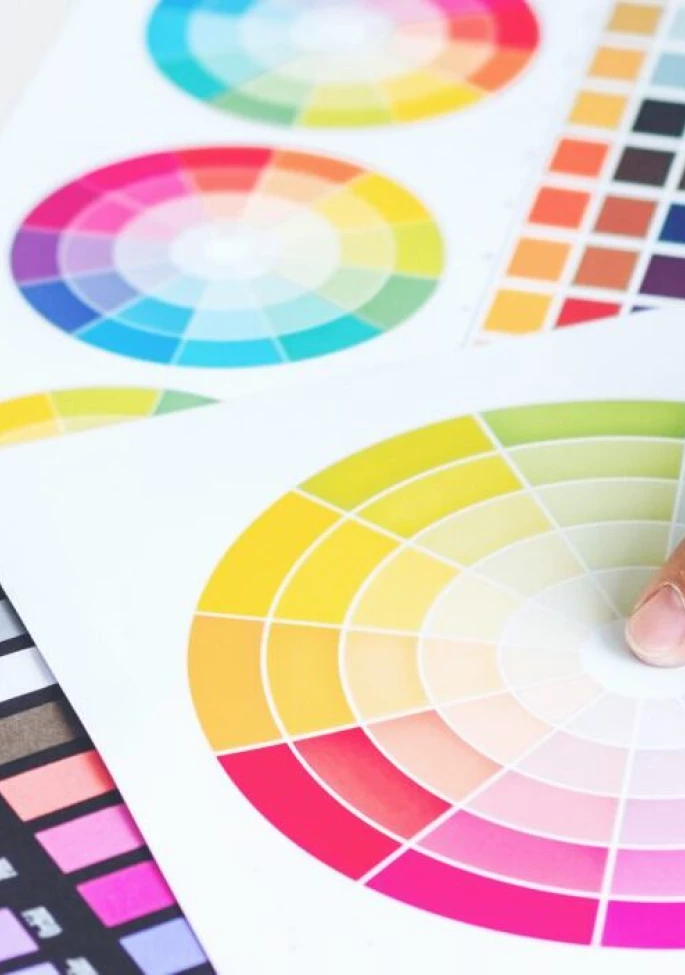Trial graphics are instrumental in conveying your story to today’s jurors. Presenting an understandable argument to a jury usually involves technology-driven visual communication in the form of demonstrative exhibits and evidence. This is particularly important in complex matters because jurors are given an opportunity to rely on visual support as well as auditory learning to absorb the concepts.
The success of courtroom visuals depends on their effectiveness with the audience—your jurors. Of course, no two jurors are exactly alike, so how can your graphics possibly speak to everyone? There are three key factors to consider: generational differences, visual communication fundamentals, and the evolution of media both inside and outside of the courtroom.
#1: Generational Differences Among Jurors
One valuable way to address the communicative power of visuals across the broad spectrum of jurors is to consider generational divisions: namely, Baby Boomers, Gen X, Gen Y aka “Millennials and Gen Z. (See chart below.)[i] As with any social science topic, there are exceptions and overlaps, but these divisions offer numerous clues about the behavioral and perceptual differences across generations.
Baby Boomers
For years, a trial attorney’s most substantial communication concerns involved simply conveying their messages clearly and keeping a jury focused. Baby Boomers are adept at—and used to—single, extended interactions or conversations.[i] These jurors might sit in the box thinking about picking up their kids or grabbing groceries afterward, but lawyers were still competing, for the most part, only with a juror’s internal dialogue. Jurors were more attuned to what might be called “Matlock moments,” in which the drama revolved around the attorney’s spoken word.
Generation X
When Gen X came along, information dissemination went through a major period of transition. Gen Xers grew up with television as a household staple and later the fledgling worldwide web, which suddenly exposed them to an enormous amount of information. With it came email, text, and image-heavy communication beyond TV.
While the internet’s breadth and speed grew exponentially, attorneys began to rely more on images to reach the jury, utilizing PowerPoint slides or other digital graphics in the courtroom. As CSI and its progeny replaced Perry Mason and Matlock, an attorney’s word alone was not good enough. Jurors increasingly expected the drama to unfold before their eyes.[ii]
Generation Y (aka Millennials)
For the most part, Gen Ys (Millennials) were born before the digital age but were young enough when it arrived that they made the transition at a young age. Millennials can handle an astounding amount of information at once but often at the expense of a dedicated attention span. These users are perpetually enveloped in social media, news media, search engines/information databases, on-demand videos, and streaming services with the touch of a finger.[iii] As such, Millennial jurors expect to see mixed media (i.e., text, images, and videos) in trial presentations.
Generation Z
Called the “digital natives,” members of Gen Z have been using technology their entire lives and do not know a world without internet, cell phones, and social media.[iv] Their attention spans are even shorter, so visual interest and movement are paramount to holding their focus in the courtroom—think 3D animations, short clips, and unique perspectives (i.e., drone footage). Gen Z is also powered by video.[v]
Younger jurors’ constant connection to information is not only a distraction outside of the courtroom, but it can also tug on their focus at trial—in addition to their internal dialogue, which knows no generational boundaries. Jurors are looking to be informed and entertained by your trial presentation. That can be a tall order.
Expectations for All Generations
New media can be defined as any media delivered digitally. Radio, TV, and hard-copy print are categorized as old (or traditional) media. The term “new media” is also constantly being refined, as innovative technologies are developed and adopted. As new platforms become popular, the landscape changes. Case in point, TikTok has surpassed Google and YouTube as the primary search engine for Gen Z.[vi] In 2022, the White House even gathered TikTok influencers to a Zoom call about the war in Ukraine, showing their awareness that TikTok was the most effective way to communicate with the largest audience.[vii]
New media is an integral part of life for jurors of all generations, and frankly, it is not all that “new” anymore. It would be a mistake to assume older generations have not adapted successfully to modern technology. Baby Boomers have embraced tablets, smartphones, social media, and bite-sized information.[viii] Particularly with the pandemic, older jurors have had to become comfortable with various forms of online communication and social media just to be able to connect to friends and family. So, while their attention spans are longer than younger jurors, they have acclimatized to new media and they now also have expectations of sophisticated multimedia presentations.
#2: Trial Graphic Fundamentals
Great graphics are a given in the lives of new media users, and savvy trial teams should expect to adapt to these expectations. However, some trial graphic basics will never go out of style, and they will still come into play with sophisticated new media graphics.
Effective graphics provide jurors with a consistent visual starting point around which they can mold their conclusions. Images that are well-produced and expertly presented will make a strong impression on jurors and will provide a common visual experience to which jurors can refer during deliberations. They will also give jurors the framework they need to retain and evaluate the case facts and your overarching story.
What Trial Graphics Should Do
- Present a cohesive story and timeline
- Incorporate strong images with relatable associations
- Apply visual analogies to make unfamiliar/complex concepts comprehensible
- Communicate with text that is easy to understand and see
- Use titles and headers effectively
- Utilize icons and colors (when possible)
- Ensure each word has meaning consistent with your message/strategy
- Group information together in bite-sized pieces
These tenets work. If your trial graphics incorporate them harmoniously, you will be more effective in reaching jurors of any generation. Maximizing your effectiveness in the modern media landscape is less about reinventing the wheel than it is about taking rock-solid graphics fundamentals and incorporating a new media twist.
What Your Graphics Are Up Against
Websites, apps, TV networks, streaming services, podcasts, social media platforms, and search engines—these are news products that facilitate the consumption of information on demand. Jurors can decide when, where and how much information they want throughout their normal day, and as a result, they have high expectations when they step into the courtroom.
Social Media
Facebook and X (formerly Twitter) remain major news and information hubs for the older generations.[ix] Younger generations are relying on Instagram and YouTube, but TikTok is catching up quickly.[x] Whether it is a 280-character tweet or 15-second reel, all ages of jurors are consuming and sharing eye-catching shortform content. Most social media posts, regardless of the platform, closely follow this trend toward brevity. To keep in line with subliminal expectations, your trial graphics should make an immediate synapse with jurors.
High-Quality Graphics Are Everywhere
A quick look around your immediate environment will reveal the fact that graphics are now commonplace, and they reach all generations. There are even sophisticated graphics overlaid on live sporting events. Gone are the days of John Madden’s rudimentary circles and lines. Now they can highlight a player and his pass route in three dimensions while providing his game or season stats in an onscreen bubble.
Infographics
Particularly relevant to trial demonstratives, hyper-polished (and sometimes animated) infographics are an eye-catching way to display a large volume of data. But these are not just pie charts made pretty; they are carefully developed to point out important patterns, consequences, and conclusions with the least possible cognitive effort for the viewer. They seamlessly blend images and icons with text, numbers, colors, and font styles.
Twenty years ago, infographics would be considered state-of-the-art. Now your average juror sees them all over social and news media, 24 hours a day. If your trial graphics do not approach the level of what your jury encounters on these platforms, you might have a communication problem in the courtroom.
#3: Adapting Graphics for Modern Juries
By sticking to the basic rules of visual communication and making tweaks with the modern juror’s expectations in mind, your trial presentation can successfully reach and resound with all ages. The examples below demonstrate how well-known trial graphics can be tweaked for today’s media landscape.
Checklists
Checklists are powerful, simple, and crystal-clear tools for reaching any audience. They offer the advantage of walking the jury through a chain of events step-by-step, as well as providing clear comparisons. Traditionally, an attorney might have stood in front of the jury and written out a checklist on a pad of paper. Over time, that paper was replaced by a PowerPoint slide with colors and icons, perhaps to denote “good” (green checkmark) or “bad” (red X).
Checklist Example 1
In the next example, we see how a checklist can be subtly updated to reflect how jurors now recognize information. While the graphic is not too busy, the viewing experience is jam-packed with understated techniques. Keywords are bolded, thereby highlighting the most important pieces for rapid intake. Portraits of key players are added to match the image/text expectations of your average modern webpage. Lastly, checkmarks are provided to immediately clue the audience to the graphic’s purpose
Checklist Example 2
While the simplicity of the first checklist graphic may appear preferable in some ways, current jurors are used to the appearance and style cues of the second example. Anything less can feel dated and is easy to tune out.
Headlines
In response to the staggering amount of information available, people are more than ever communicating in eye-grabbing, bite-sized pieces—essentially headlines. To cut through the noise, each piece must be informative, engaging, precise, and brief. Stylized imagery meshes with stylized text in a battle for the subject’s limited time and attention. Consider the following fictional news example.
Headline Example 1 (Source: Law360.com)
The content still resonates with older generations, but the design has the brevity and flair to which younger generations have grown so accustomed. Note the stylistic choices: the use of color, large text, and a larger subject image, without cluttering up the screen. Below is an example of how that style can influence your trial graphics.
Headline Example 2
The speaker in this second example is immediately apparent. The portrait is bigger than we would have considered in the past, but it matches viewers’ expectations while connecting to case themes and helping to humanize the client. Key responses are bolded, and there is a short thematic slide header.
Data Trends
In the earlier days of trial graphics, demonstrating a data point trend might look a little like the fictitious example below. We will call the company “ACME.”
Data Trends Example 1
In this mock-up, you can see how ACME’s cash on hand was shrinking over time, or you could put together a basic timeline demonstrating the downward slope. Nowadays, representing data in that fashion likely would be met with boredom. You will need to take a page from modern infographics to keep your audience interested and to help jurors quickly draw the right conclusions.
Data Trends Example 2
This second graphic invites the viewer to zone right in on the circled beginning and end points and watch how ACME’s cash deteriorates over time. Moreover, a large red arrow icon summarizes and capitalizes on the point, highlighting in large text the percentage of the decline. Color is used boldly to denote financial loss and guide the viewer’s eyes to the most important sections of the image.
Timelines
The following modernized timelines also use subtle techniques to point jurors’ eyes where we want them. New media relies on attractive images to grab one’s attention, so we must do the same. Colors, icons, and short-but-sweet text keep it interesting while making case points. Each title cements the graphic’s core theme.
Timeline Example 1
In this first example, colorful lines (each with a corresponding icon) show the moment that safety at this plant began to take a backseat to production levels. Jurors see the plant’s physical condition and the number of maintenance technicians declining while production increases—a counterintuitive notion demonstrating our opponent’s irresponsible practices. The trend inevitably leads to a plant explosion, fittingly represented by bright red spikes.
Timeline Example 2
Likewise, in the second timeline example, services rendered soon fade from good to bad. Each data point connects to a bite-sized quote, linking the evidence—in small, digestible pieces—to our chronology. Observe that the coloring reinforces our argument; jurors can witness the exact point at which quality drops off (and continues to decline).
Finding Balance in the Courtroom
The examples above reflect the evolving ways in which jurors take in information. But what may not be readily apparent is how graphics weather the inevitable balancing act between a judge and opposing counsel—a tightrope walk between what is allowed and what will be most effective with jurors. If your opponent successfully objects to one graphic, and your PowerPoint is full of similar slides, you have just lost your whole slide deck. Keep that in mind, and make sure you do your homework about what the judge in your case will accept when it comes to visuals.
In Conclusion
Speaking of balance, the goal here is not to suggest everything you present at trial needs to be in the form of a special graphic. Variety is extremely important to hold the jury’s attention. There is an art to understanding how much is too much and knowing when to put down the clicker and just speak to the jury, or when that big pad of paper and a few colored markers might be exactly the right tools for the job.
But when you do use graphics—and you should, often—be mindful of the effect that new media has on your jurors. In the end, even older generations have been influenced by the major shift in information acquisition. Younger jurors certainly do not know a world without sophisticated visuals and videos.
When you are crafting trial graphics, it is important to walk before you run. Start with fundamentals to ensure more positive results, then hone each graphic to a fine point by using the tips above and staying up to date with how your audience expects to receive information. And remember, as technology continues to shift over time, attorneys must be prepared to adapt to the evolving multimedia that new generations will have at their disposal.
This article is an update to the original three-part series published in 2022. A version was also published by Law360.com in 2023.
References
[i] Adapted from https://www.pewresearch.org/fact-tank/2019/01/17/where-millennials-end-and-generation-z-begins/
[ii] Gardiner, Alistair. “From Boomers to Zoomers: Crossing the communication divide at work.” MDLinx. September 20, 2021. See https://www.mdlinx.com/article/from-boomers-to-zoomers-crossing-the-communication-divide-at-work/5sGEpOlr4ShazPsyrVoXJP
[iii] Shelton, The Hon. Donald E. “The 'CSI Effect': Does It Really Exist?” National Institute of Justice. March 16, 2008. See https://nij.ojp.gov/topics/articles/csi-effect-does-it-really-exist
[iv] Media Insight Project. “The news consumption habits of 16-40 year olds.” American Press Institute. August 31, 2022. See https://www.americanpressinstitute.org/publications/reports/survey-research/the-news-consumption-habits-of-16-to-40-year-olds/#:~:text=Indeed%2C%20on%20average%2C%20those%20surveyed,%3B%2045%25%20do%20so%20daily
[v] What is Gen Z? (2023, March 20). McKinsey & Company. https://www.mckinsey.com/featured-insights/mckinsey-explainers/what-is-gen-z
[vi] Baron, Jessica. “The Key to Gen Z is Video Content.” Forbes. July 3, 2019. See https://www.forbes.com/sites/jessicabaron/2019/07/03/the-key-to-gen-z-is-video-content/?sh=5b573d193484
[vii] Huang, Kalley. “For Gen Z, TikTok Is the New Search Engine.” The New York Times. September 17, 2022. See https://www.nytimes.com/2022/09/16/technology/gen-z-tiktok-search-engine.html
[viii] Lorenz, Taylor. “The White House is briefing TikTok stars about the war in Ukraine.” The Washington Post. March 11, 2022. See https://www.washingtonpost.com/technology/2022/03/11/tik-tok-ukraine-white-house/
[ix] Faverio, Michelle. “Share of those 65 and older who are tech users has grown in the past decade.” Pew Research Center. January 13, 2022. See https://www.pewresearch.org/fact-tank/2022/01/13/share-of-those-65-and-older-who-are-tech-users-has-grown-in-the-past-decade/
[x] Morrison, Stella. “How to Target Older Demographics with Social Media Marketing.” Business News Daily. August 5, 2022. See https://www.businessnewsdaily.com/10146-target-older-demographics-social-media.html
[xi] Rosenblatt, Kalhan. “Gen Z is over Facebook, Pew Research Center finds.” NBC News. August 10, 2022. See https://www.nbcnews.com/tech/tech-news/gen-z-facebook-pew-research-center-finds-rcna42429







